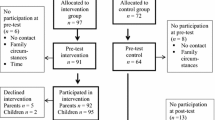Abstract
The applicability of the definition of the borderline syndrome to children is questioned, as is the traditional view that its etiology lies in the type of interaction the child had with its parents. The redefinition of the syndrome of borderline proposed in prior publications using the conceptual framework of self psychology opens the door to new treatment approaches. This article addresses some of the issues related to these treatment approaches.
Similar content being viewed by others
References
Adamson, W. C., & Adamson, K. K., (Eds.) (1976).Handbook for specific learning disabilities. New York: Gardner Press. pp. 3–62.
Adler, G., & Buie, D. H., (1979). Aloneness and borderline psychopathology: The possible relevance of child developmental Issues.International Journal of Psycho-Analysis, 60, 83–96.
Andrulonis, P. A., Glueck, B. C., Stoebel, C. F., Vogel, N. G., Shapiro, A. L., & Aldridge, D. M., (1980).Organic brain dysfunction and the borderline syndrome, Psychiatric Clinics of North America.4, 47–66.
Beres, D., (1971). Ego autonomy and ego pathology.Psychoanalytic Study of the Child, 26, 3–24.
Chethic, M., & Fast, I., (1970). A function of fantasy in the borderline child.American Journal of Orthopsychiatry, 40, 756–765.
Chethic, M., (1979). The borderline child. In Hoshpitz,The handbook of child psychiatry. New York: Basic Books. Vol. 2, pp. 304–320.
Duane, D. D., (1977). Developmental dyslexia: Etiologic theories & therapeutic implications.Psychiatric Annals, 7, 34–47.
Ekstein, R., & Wallerstein, J. (1954) Observations on the psychology of borderline and psychotic children.Psychoanalytic Study of The Child, 9, 344–369.
Ekstein, R., & Wallerstein, J., (1956). Observations on the psychotherapy of borderline and psychotic children.Psychoanalytic Study of The Child, 11, 303–311.
Fast, I., & Chethic, N., (1972). Some aspects of object relationships in borderline children.International Journal of Analysis, 53, 479–486.
Freedman, D. A., (1981). The effect of sensory & other deficits in children on Their Experience of Other People.Journal of the American Psychoanalytic Association, 29, 831–868.
Frijling-Schreuder, E. C., (1979). Borderline states in children.Psychoanalytic Study of the Child. 24, 307–327.
Geleerd, E. (1958). The Borderline Child. Psychoanalytic Study of The Child,15, 19–41.
Grotstein, J.S. (1977). The Psychoanalytic concept of Schizophrenia: I. the Dilemma.International Journal of Psychoanalysis, 58, 403–425.
Kohut, H., & Wolf, E., (1978). The disorders of the self & their treatment: An outline.International Journal of Psycho-Analysis. 59, 413–425.
Kohut, H., (1971).The analysis of the self. New York International Universities Press.
Kohut, H., (1977).The restoration of the self. New York: International Universities Press.
Lesser, S. R., & Easser, B. R., (1972). Personality differences in the perceptually handicapped.Journal of the American Academy of Child Psychiatry, 2, 458–466.
Leventhal, D. S., (1968). The significance of ego psychology for the concept of minimal brain dysfunction in children.Journal of the American Academy of Child Psychiatry, 7, 242–251.
Murray, N. E., (1979). Minimal brain dysfunction & borderline personality adjustment.American Journal of Psychotherapy, 33, 391–403.
Ornstein, A., (1976). Making contact with the inner world of the childComprehensive Psychiatry, 7, 1.
Ornstein, P. A., (1981). The bipolar self in the psychoanalytic treatment process: Clinicaltheoretical considerations. Journal of the American Psychoanalytic Association,29, 353–394.
Palombo, J., & Feigon, J., (1984). Borderline personality in childhood and neurocognitive deficits.Child & Adolescent Social Work Journal, 1, 18–33.
Palombo, J., (1979). Perceptual deficits and self-esteem in adolescence.Clinical Social Work Journal, 7, 34–61.
Palombo, J. (1982). Critical review of the concept of the borderline child.Clinical Social Work Journal, 10, 246–264.
Palombo, J., (1983). Borderline conditions: A perspective from self psychology.Clinical Social Work Journal, 11, 323–338.
Palombo, J., (1984). Selfobject transference in the treatment of borderline neurocognitively impaired children. In Grotstein, J. S., Solomon, M., and Lang, J., (Eds.),The borderline patient; emerging concepts in diagnosis, psychodynamics, and treatment. New Jersey: The Analytic Press.
Pine F., (1974). The Concept of “borderline” in children: A clinical essay.Psychoanalytic Study of the Child., 29, 241–368.
Robson, K. S., (Ed.) (1983).The borderline child: Approaches to etiology, diagnosis, and treatment. New York: McGraw-Hill.
Rosenfeld, S., & Sprince, M., (1963). An attempt to formulate the meaning of the concept “borderline.”Psychoanalytic Study of the Child, 18, 603–635.
Silver, L. B., (1971). A proposed view of the etiology of the neurological learning disability syndrome.Journal of Learning Disability, 4, 123–133.
Silver, L. B. (1979a). Children with perceptual and other learning problems. In Hoshpitz,The handbook of child psychiatry. New York: Basic Books. Vol. 3, pp. 605–614.
Silver, L. B. (1979b). The minimal brain dysfunction syndrome. In HoshpitzThe handbook of child psychiatry. New York: Basic Books. Vol. 2, 416–438.
Silver, L. B., (1981). The relationship between learning disabilities, hyperactivity, distractibility, and behavioral problems,Journal of Child Psychiatry, 20, 385–397.
Tolpin, P. (1980). The Borderline personality: Its makeup and analyzability. In Goldberg (Ed.)Advances in self psychology. New York: International Universities Press, pp. 299–316.
Weil, A. P. (1973). Children with minimal brain dysfunctions: Diagnostic and therapeutic considerations. In Sapin & Hitzburg (Eds.),Children with learning problems. New York: Brunner/Mazel, pp. 551–560.
Weil, A. P. (1978). Maturational variations and genetic-dynamic issues.Journal of the American Psychoanalytic Association, 26, 461–492.
Wolfe, H. S. (1979). Countertransference in disorders of the self. In: Epstein & Feiner (Eds.)Countertransference. New York: Jason Aronson, pp. 445–464.
Author information
Authors and Affiliations
Rights and permissions
About this article
Cite this article
Palombo, J. The treatment of borderline neurocognitively impaired children: A perspective from self psychology. Clin Soc Work J 13, 117–128 (1985). https://doi.org/10.1007/BF00755477
Issue Date:
DOI: https://doi.org/10.1007/BF00755477




